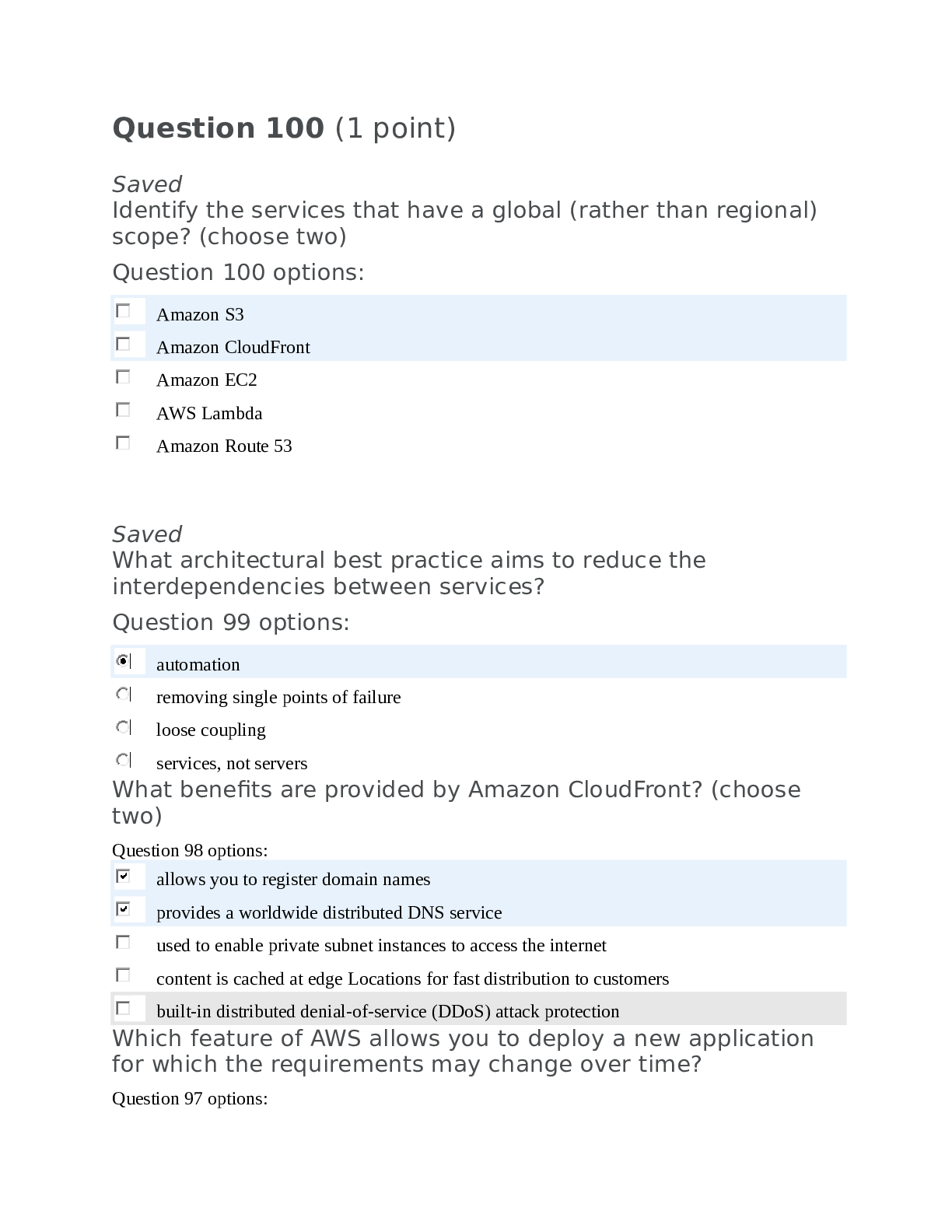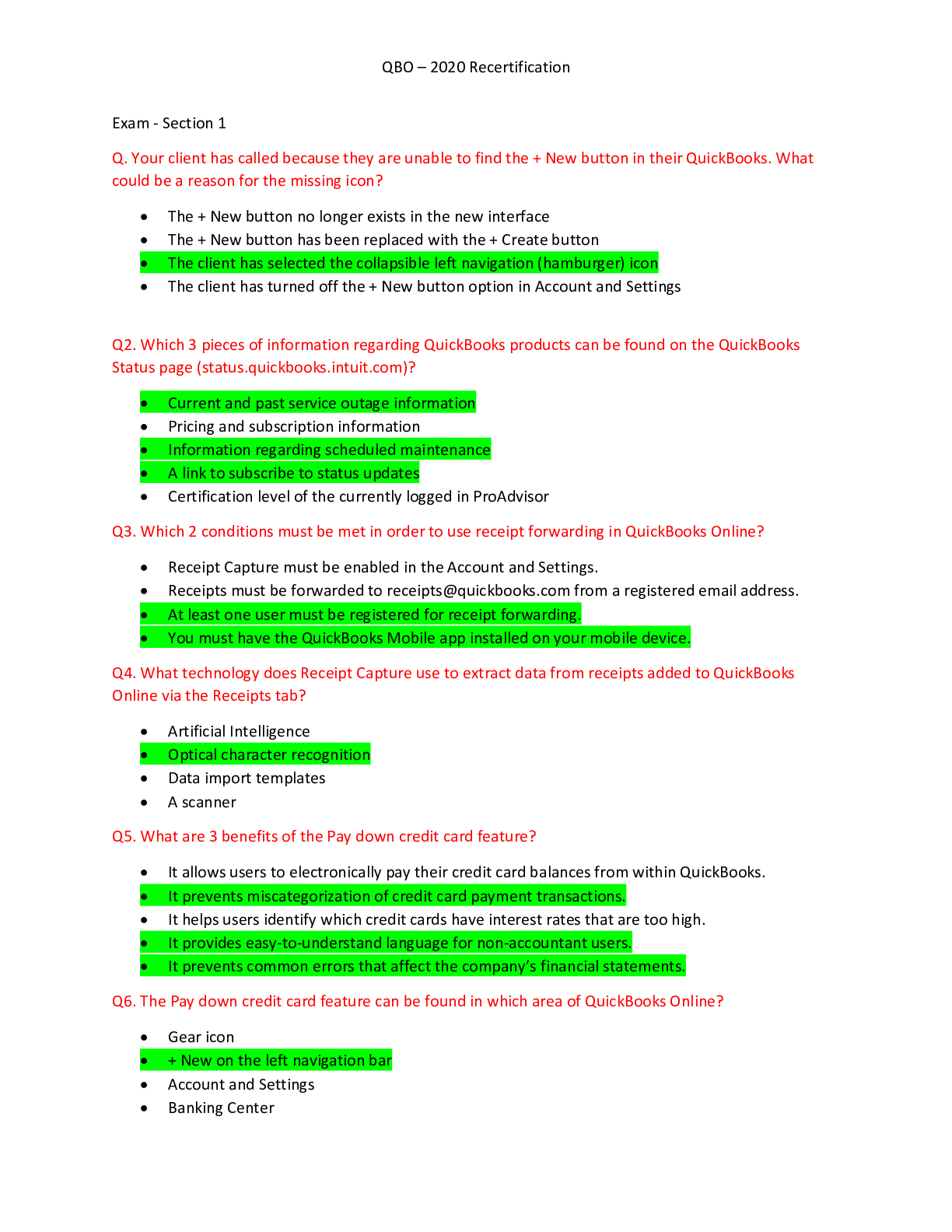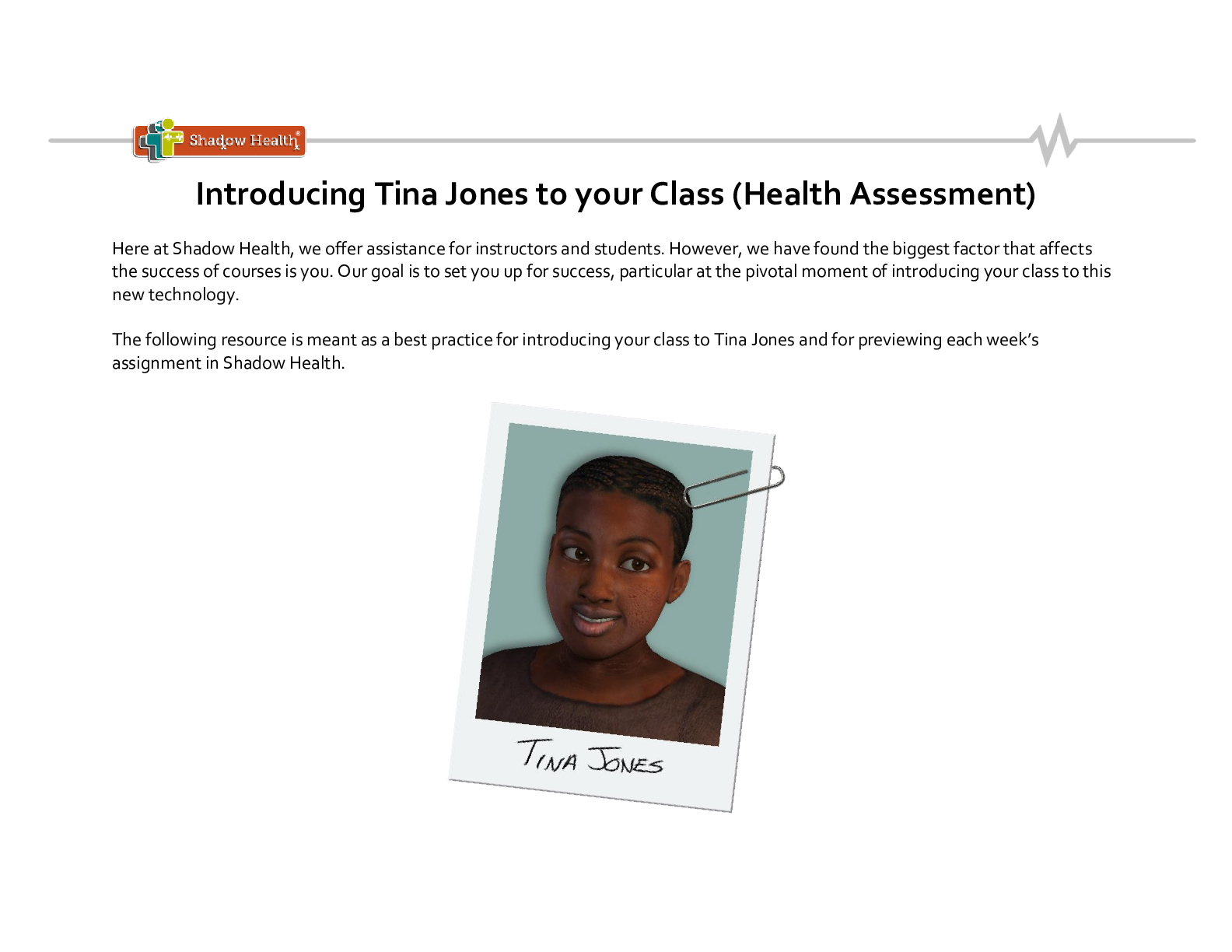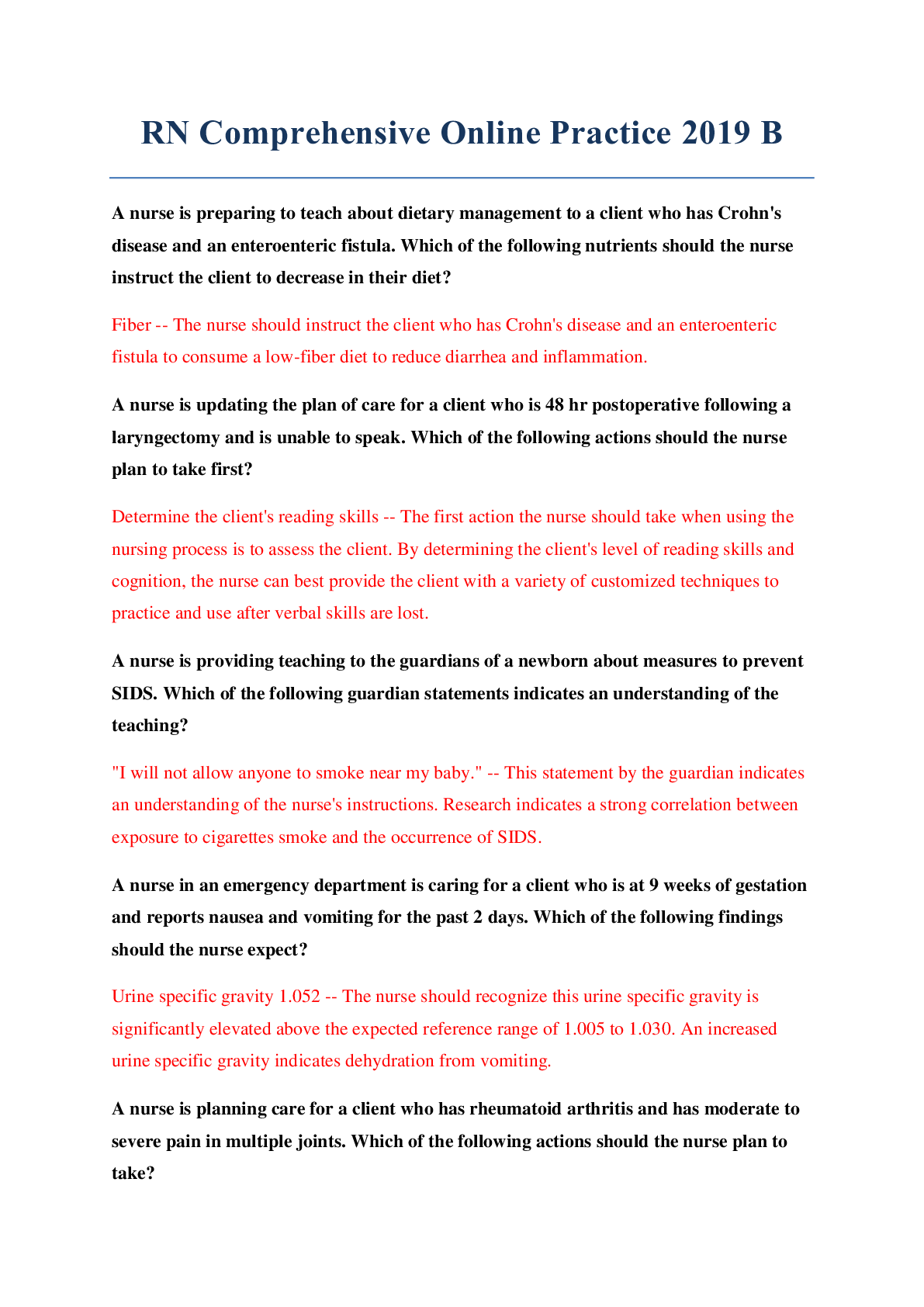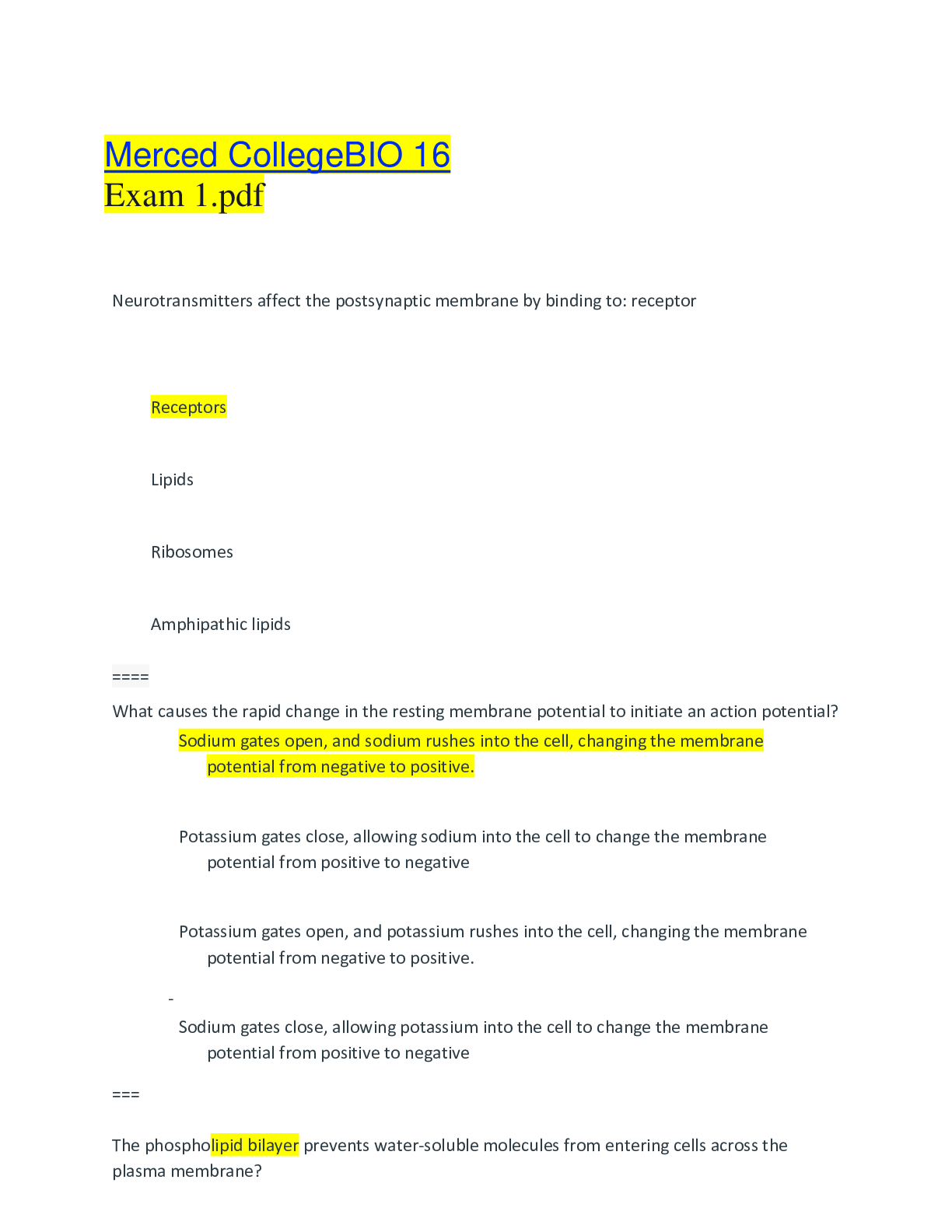*NURSING > EXAM > University of Texas, Rio Grande Valley - NURSING 3302: Compiled quiz questions no repeats (All)
University of Texas, Rio Grande Valley - NURSING 3302: Compiled quiz questions no repeats
Document Content and Description Below
University of Texas, Rio Grande Valley - NURSING 3302: Compiled quiz questions no repeats A patient with a history of heart failure is being treated with digoxin (Lanoxin). The nurse knows that thi... s medication increases the force of contractions of the heart. What effect improves the contractility of the heart? Positive inotropic effect A patient has an elevated BUN and creatinine. The patient has been prescribed digoxin (Lanoxin) for heart failure. What aspect of care is the priority regarding this patient? The dose should be decreased in this patient. The home care nurse sees a patient for the first time. The patient has crackles in the lower lobes of the lungs, an audible S3, and pitting edema in the feet and ankles. What condition is the patient most likely experiencing? A. Myocardial infarction B. Liver disease C. Pneumonia D. Heart failure A patient is being treated for heart failure. Which of the following is most indicative of improved health status? A. Decreased pedal edema B. Increased skin turgor C. Improved sensorium D. Heart rate of 52 An older adult patient has been receiving treatment for heart failure and has been experiencing frequent episodes of peripheral edema. As a result, her care provider has added furosemide (Lasix) to her medication regimen. What assessment should the nurse perform on a daily basis for the duration of treatment? A. Pupillary response B. Magnesium level C. Body weights D. Arterial blood gasses A patient is experiencing nausea and visual disturbances when taking digoxin (Lanoxin). Which of the following medications will be administered? Digoxin immune fab (Digibind) A gerontological nurse is aware that increased aldosterone is a major factor in the pathophysiology of heart failure. Which of the following medications reduces aldosterone-induced retention of sodium and water? Spironolactone A patient is being administered digoxin (Lanoxin) for treatment of heart failure. At what level should the serum potassium level be maintained? 3.5 to 5.0 mEq/L When instructing a patient on the use of a nitroglycerin patch, what should the patient be taught regarding the advantage of the nitroglycerin patch? It has a longer duration of action. A patient is admitted to the emergency department with chest pain that is unrelieved with sublingual organic nitrates. What medication will most likely be administered? Intravenous Nitroglycerin A medical nurse has administered an oral dose of 30 mg nifedipine long-acting to a patient with a diagnosis of angina. What principle should guide the nurse's follow-up assessment after administering this drug? A. The patient’s blood pressure, heart rate, and oxygen saturation level should be assessed 30 minutes after administration of nifedipine B. Nifedipine has the potential to induce prodysrhythmic effects C. Nifedipine does not affect heart rate, so assessment after administration is not normally necessary D. The patient’s heart rate will be at the lowest; approximately 45 minutes to 1 hour after oral administration of nifedipine A patient with a long-standing diagnosis of asthma is prescribed a beta-blocker for the treatment of angina. The nurse should consequently prioritize assessment for what health problem? A. Hyperglycemia B. Bronchospasm C. Pneumonia D. Pleural effusion An elderly patient has begun taking bisoprolol (Zebeta) 10 mg PO once daily for the treatment of angina. The nurse should administer this drug in the knowledge that it achieves a therapeutic effect in what way? A. Prolonging the QT interval B. Increasing the force of myocardial contractions C. Shortening the time required for repolarization D. Decreasing heart rate A patient is prescribed ranolazine (Ranexa) to treat chronic angina. Which of the following electrocardiogram changes will contraindicate the use of ranolazine? A. QT prolongation B. Shortened QRS C. Inverted P wave D. Normal ST segment A 59-year-old male patient has a long history of heavy alcohol use and was diagnosed with liver cirrhosis several months earlier. The patient's medical history includes numerous other health problems, including angina. When considering the use of nifedipine in the management of this patient's angina, what consideration should the nurse be aware of? A. Nifedipine is contraindicated because it is highly hepatoxic B. The patient is likely to experience an increased effect of the medication C. The patient’s increased albumin levels will negate the therapeutic effect D. This patient will require a higher dose than a patient without this medical history A patient has been taking digoxin (Lanoxin) for 5 years for the treatment of heart failure. In the last 3 months, she has noticed she is tired all the time, her heart rate is very slow, and she is always cold. The nurse assessing the patient notes her blood pressure at 88/50 and pulse rate is 44. The nurse instructs the patient not to take her digoxin. What condition may the patient be suffering from that would contraindicate the administration of digoxin? A. Hypothyroidism B. Cerebrovascular accident C. Intermittent claudication D. Myocardial infarction A patient has been administered nesiritide (Natrecor) to manage symptoms of acute heart failure. How does the drug act? A. Nesiritide (Natrecor) increases the concentration of acetylcholine to potentiate the action of ACE. B. Nesiritide (Natrecor) exhibits mild inotropic action and decreased platelet aggregation C. Nesiritide (Natrecor) compensates for cardiac deterioration by reducing preload and afterload D. Nesiritide (Natrecor) corrects hyperthyroidism by inhibiting synthesis of the thyroid hormone When instructing a patient on a no-added-salt diet, the nurse should instruct the patient on foods with hidden salt. Which of the following foods has hidden salt and should be avoided? A. Canned soup B. Ice cream C. Dehydrated apple chips D. Bread A patient is admitted to the intensive care unit with an electrolyte imbalance. Which of the following imbalances will contraindicate the administration of digoxin (Lanoxin)? A. Hyperkalemia B. Hypokalemia C. Hypermagnesemia D. Hypocalcemia A patient with coronary artery disease is prescribed nitroglycerin ointment. When teaching the patient to safely administer this medication, the nurse should convey which of the following instructions? “Make sure you squeeze the ointment on to a paper measuring scale before applying it.” A nurse has administered a scheduled dose of 50-mg atenolol PO for the treatment of angina. Following administration, the nurse should prioritize what assessment? A. SaO2 B. Oral temperature C. Level of consciousness D. Blood pressure A patient is beginning therapy with isosorbide dinitrate (Isordil). When will the nurse know that the patient has maximal tolerance? A. When a headache develops B. When the heart rate increases to 100 C. When halos are seen around lights D. When nausea develops The nurse is teaching the patient about angina pectoris. Which of the following statements by the patient indicates that he has understood the teaching? A. “High fat in the diet and smoking can cause my episodes of chest pain.” B. “My high blood pressure has no effect on my episodes of chest pain.” C. “I will avoid exercise because it will precipitate my angina.” D. “As long as I take my medicines, I will not need to decrease my fat intake.” A patient is admitted to the hospital with a diagnosis of heart failure. The patient is ordered to receive furosemide (Lasix) 40 mg IV. How soon after administration should the nurse expect to see evidence of diuretic effects? A. 5 minutes B. 2 hours C. 30 minutes D. one minute A patient is receiving furosemide (Lasix) and a potassium supplement. When monitoring daily laboratory values, what should the potassium level be for this patient? A. 5.0 to 7.5mEq/L B. 6.0 to 6.5mEq/L C. 3.5 to 5.0mEq/L D. 1.5 to 3.0mEq/L A patient has been prescribed digoxin (Lanoxin) and furosemide (Lasix) for treatment of congestive heart failure. What is the patient at risk for developing with this combination of medications? A. Hyperkalemia B. Digoxin toxicity C. Hyperglycemia D. Tachycardia A patient is taking spironolactone (Aldactone). When providing patient teaching about this medication, what foods should the patient be instructed to avoid? A. Fish B. Crackers C. Bananas D. Apples A patient is admitted to the emergency department and is unconscious as a result of a head injury. The patient's intracranial pressure is increased. What type of diuretic will the nurse most likely administer to the patient? A. Thiazide diuretic B. Potassium-sparing diuretic C. Loop diuretic D. Osmotic diuretic A patient has been taking an ACE inhibitor and a beta-blocker for the treatment of hypertension but has been consistently obtaining blood pressure readings in the vicinity of 145/90 mm Hg. As a result, the patient's primary care provider has prescribed furosemide (Lasix). What order would be most consistent with this patient's health needs? A. Lasix 20 mg IV OD B. Lasix 125 mg PO OD C. Lasix 40 mg PO BID D. Lasix 40 mg IV TID A patient with hypertension has been prescribed a combination diuretic. What is the major purpose in administering a combination diuretic agent? A. It is less expensive than two medications B. It prevents sodium imbalance C. It prevents allergic reactions D. It prevents potassium imbalance An elderly man who resides in a care facility has been prescribed antihypertensives for the first time following many years of generally good health. When administering the first dose of the prescribed medications, the nurse should recognize what nursing diagnosis? A. Risk for falls related to antihypertensive medications B. Risk for infection related to antihypertensive medications C. Risk for impaired oxygenation related to antihypertensive medications D. Risk for acute confusion related to antihypertensive medications An African American patient is being treated for a new diagnosis of hypertension. What antihypertensive agent is the most likely drug of choice for this patient? A. beta-adrenergic blocker B. calcium channel blocker C. diuretic D. vasodilator When providing dietary instruction on a low-sodium diet, which dietary choice is most appropriate for a patient with hypertension? A. Grilled hamburger, french fries, and cola B. Ham sandwich, potato chips, and cookie C. Hot dog, baked beans, and coleslaw D. Grilled chicken, green salad, and apple A patient is being treated in the hospital for a femoral fracture and is scheduled to receive his daily dose of metoprolol (Lopressor) that he has been taking for the treatment of hypertension for several years. Prior to administering this drug, the nurse should assess and document which of the following? Select all that apply. Blood pressure and heart rate A patient with diabetes mellitus is prescribed captopril (Capoten) to treat hypertension. What electrolyte imbalance might the patient be prone to develop? A. Hypernatremia B. Hypokalemia C. Hypermagnesemia D. Hyperkalemia A nurse is working with an adult patient who has recently been diagnosed with hypertension and begun combination therapy. Which of the patient's following statements would suggest a need for further health education? A. “My wife and I are thinking of ways that we can cut down the amount of salt in our diet.” B. “I’ll only need to take these drugs on days when my blood pressure is particularly high.” C. “I’m going to make up a schedule for checking my blood pressure on a regular basis.” D. “I’ve made plans with my best friend to start going for walks in the morning four times a week.” A patient is prescribed losartan (Cozaar). The medication alone is not effective in controlling blood pressure. What medication will best increase the effectiveness of blood pressure control in this patient? A. Hydrochlorothiazide (HCTZ) B. Atorvastatin calcium (Lipitor) C. Digoxin (Lanoxin) D. Hydralazine hydrochloride A patient started taking ramipril earlier in the week for the treatment of hypertension. At her latest clinic visit, she has stated that she now has a “nagging, dry cough.” How should the nurse best follow up the patient's statement? A. Inform the patient that the drug should be immediately discontinued B. Explain why it will be necessary to obtain a sputum sample C. Explain that drugs like ramipril often cause a cough. D. Inform the patient that this is an adverse effect on the medication that may lead to pneumonitis A hospital patient with a diagnosis of liver failure has been prescribed a low dose of spironolactone in order to treat ascites. The nurse who is providing this patient's care should prioritize assessments for the signs and symptoms of what health problem? A. Peritonitis B. Liver cancer C. Hepatic encephalopathy D. Cirrhosis A patient has edema of the lower extremities with crackles in the lung bases. What diuretic is the nurse most likely to administer? A. Mannitol B. Furosemide C. Hydrochlorothiazide D. Spironolactone The physician has ordered the patient hydrochlorothiazide. What assessment should the nurse make before administering the first dose of hydrochlorothiazide? A. Sulfonamide allergy B. Hemoglobin level C. Neutrophil level D. Pulse rate A patient has had multiple blood pressure readings that indicate he has hypertension. How is hypertension defined? A. Systolic pressure above 150mmHg or diastolic pressure above 100mmHg B. Systolic pressure above 140mmHg or diastolic pressure above 90mmHg C. Systolic pressure above 160mmHg or diastolic pressure above 110mmHg D. Systolic pressure above 130mmHg or diastolic pressure above 95mmHg A patient has recently been diagnosed with hypertension. Which of the following outcomes is most important in this patient? A. Compliance with a low-sodium diet B. Compliance with antihypertensive medications C. Multiple diastolic blood pressure readings <90 mm Hg D. Verbalization of an understanding of medical regimen A patient is prescribed a potassium-sparing diuretic. What electrolyte imbalance would the patient be prone to develop? A. Hypernatremia B. Hyperkalemia C. Hyponatremia D. Hypokalemia A patient states that he is seeing halos around lights. The patient takes digoxin (Lanoxin) by mouth every day. The physician orders the patient to have serum digoxin level drawn. At what digoxin level would the care team first suspect that the patient is experiencing toxicity? A. 6.0ng/mL B. 1.5ng/mL C. 3.0ng/mL D. 0.5ng/mL A patient is admitted to the emergency department with severe heart failure. Milrinone (Primacor) is administered IV. For what adverse effect should the patient be assessed? A. Lethargy B. Hypertension C. Atrial dysrhythmias D. Bradycardia A 77-year old patient was diagnosed with heart failure 3 years ago, and he had achieved reasonable symptom control with digoxin. In the last several months, his cardiac function has decreased significantly and his cardiologist has prescribed nesiritide during his current admission. What aspect of this patient’s health status would potentially contraindicate the administration of nesiritide? A. Irregular apical heart rate B. Presence of +2 peripheral edema C. Blood pressure of 88/50mm Hg D. Jaundice A patient who has been prescribed digoxin (Lanoxin) is also taking furosemide (Lasix) 20mg daily. Which of the following electrolyte imbalances will precipitate the development of digoxin toxicity? A. Hyperkalemia B. Hypermagnesemia C. Hypokalemia D. Hyponatremia A patient with a history of angina has sustained a mild head injury in a motor vehicle accident. He has nitroglycerin tablets for chest pain and asks the nurse for one due to chest pain. What effect will the nitroglycerin have on the patient’s current status? A. Nitroglycerin will increase intracranial pressure B. Nitroglycerin will cause decreased cerebral edema C. Nitroglycerin will raise the patient’s blood pressure D. Nitroglycerin will decrease blood glucose A patient has edema in the lower extremities and abdomen. What is the reason for administering a stronger diuretic than a thiazide diuretic to this patient? A. A thiazide diuretic will be excreted in more than 72 hours B. A thiazide diuretic will reabsorb potassium in the distal tubule C. A thiazide diuretic will provide peak effects in 2 hours D. A thiazide diuretic will be ineffective for immediate diuresis A patient asks the nurse why she has to take two diuretics when her friend only takes one with a combination medication. The patient takes hydrochlorothiazide 75mg every day with a potassium-sparing diuretic. What is the nurse’s best response? A. “The combination medications are not as effective as two medications.” B. “It could be that you need a larger dose than is available in the combination medications.” C. “Maybe you should speak with your doctor about the combination.” D. “I do not know why your doctor prefers that you take two medications.” A community health nurse is facilitatng a health promotion session to a group of seniors. Which of the following is most important to instruct regarding hypertension? A. Hypertension will increase the risk of heart disease B. Vigorous exercise will increase risk of hypertension C. An increase in sodium is recommended with hypertension D. Hypertension will increase the risk of cancer. A patient is diagnosed with hypertension, and the care team is establishing the best medication regimen to match the patient’s decreased level of function. Which of the following can be administered by transdermal patch? A. Candesartan (Atacand) B. Amlodipine (Norvasc) C. Clonidine (Catapres) D. Enalapril (Vasotec) After obtaining several elevated blood pressures readings from the automated sphygmomanometer in his local drugstore, a 51-year-old man sought care from his primary care provider. The patient has been diagnosed with hypertension following several elevated blood pressure readings. The nurse at the clinic should recognize which of the following drug regimens as being most likely? A. Monotherapy with an ACE inhibitor B. Monotherapy with a loop diuretic C. A thiazide diuretic combine with a beta-blocker D. A beta-blocker combined with a calcium channel blocker A patient is diagnosed with high blood pressure. Which of the following events occurs in a patient with hypertension? A. Cardiac output increases and in turn causes an increase in blood pressure B. Fluid loss increases blood volume in the patient with hypertension C. The kidneys excrete more fluid in response to increased blood pressure D. Decreased blood volume increases blood pressure. A patient who is malnourished and has hypertension is being treated with losartan (Cozaar). How should the dose of the medication be adjusted in this patient? A. The dose should remain the same as normal B. The medication should be combined with a diuretic C. The dose should be lower than normal D. The dose should be higher than normal A patient is experiencing episodes of chest pain. He smokes one pack of cigarettes per day and has done so for many years. When teaching him about the effect of smoking on the cardiovascular system, the nurse will teach the patient about the effects of nicotine, including which of the following? A. It increases high-density lipoproteins. B. It diminishes the blood's ability to clot. C. It increases catecholamines to increase heart rate. D. It increases myocardial contractility of the heart. A patient has substernal chest pain that radiates to the neck. The pain lasts 5 minutes and then subsides with relaxation. What is the most likely cause of the chest pain? Answers: A. Intermittent claudication B. Angina pectoris C. Myocardial infarction D. Hypertension A hospital patient with peripheral edema has been prescribed furosemide (Lasix). How should the nurse best determine the extent of the patient's desired fluid loss? Answers: A. Weigh the patient daily. B. Assess the patient's skin turgor on a daily basis. C. Auscultate the patient's chest each morning. D. Test the osmolarity of the patient's urine regularly. An elderly patient with a history of heart failure has presented to the emergency department in respiratory distress. Assessment reveals the presence of pulmonary edema, and an infusion of IV furosemide (Lasix) has been ordered. For the duration of treatment, the nurse should prioritize assessments related to what nursing diagnosis? A. Risk for deficient fluid volume related to diuretic administration B. Functional urinary incontinence related to diuretic administration C. Ineffective health maintenance related to pulmonary edema D. Risk for decreased cardiac output related to adverse effects of furosemide A patient is administered furosemide (Lasix) 20 mg PO every morning. What effect will a diet high in sodium have on the patient? A. Decreased blood pressure B. Decreased diuresis C. Hyperglycemia D. Hyperkalemia A patient is being administered enalapril maleate (Vasotec). Which of the following diuretics can be combined with ACE inhibitors to increase effectiveness in decreasing blood pressure? Answers: A. Osmotic diuretics B. Thiazide diuretics C. Potassium-sparing diuretics D. Loop diuretics A patient is diagnosed with heart failure. She asks the nurse for further details about heart failure. Which of the following statements is most accurate? A. “Heart failure can be caused by atherosclerotic plaque due to high-fat diets.” B. “The use of digoxin will slow heart rate to make your heart more efficient.” C. “Hypothyroidism will result in decreased heart rate and development of heart failure.” D. The administration of diuretics increases blood volume, causing symptoms to abate.” A nurse has poured a hospital patient's scheduled dose of hydrochlorothiazide (HCTZ). The nurse should know that this drug reduces preload by which of the following means? A. Increasing renal excretion of sodium and water B. Exerting a direct relaxant effect on the vascular smooth muscle C. Stimulating the SA node to fire more frequently D. Increasing the contractility of myocardial fibers A patient is diagnosed with erectile dysfunction. He asks what effect sildenafil (Viagra) has because he is taking nitroglycerin for chest pain. What is the best explanation for why nitrates are contraindicated with sildenafil (Viagra)? A. “Nitroglycerin and Viagra cause a severe decrease in blood pressure.” B. “Nitroglycerin and Viagra will diminish the effectiveness of chest pain relief.” C. “Nitroglycerin and Viagra can lead to prostate cancer.” D. “Nitroglycerin decreases the effect of Viagra for erectile dysfunction.” A patient with angina is prescribed propranolol (Inderal). Following absorption of the drug, the nurse should expect to assess A. relief of fatigue B. decreased heart rate C. increased oxygen saturation levels D. mild to moderate drowsiness A patient is experiencing chest pain and administers her nitroglycerin sublingually. When should the patient expect to notice relief of her chest pain? A. 1 to 3 minutes B. 15 to 20 minutes C. 5 to 10 minutes D. 30 to 60 minutes Oral atenolol has been ordered for a resident of a long-term care facility who has a diagnosis of angina. Which of the following assessment findings would prompt the nurse to withhold a scheduled dose of the drug? Select all that apply A. Blood pressure of 141/92 mm Hg B. Heart rate of 68 beats per minute C. Heart rate of 58 beats per minute D. Oxygen saturation of 90% on room air E. Blood pressure of 88/49 mm Hg A clinical nurse educator on a nephrology and dialysis unit is reviewing renal physiology with a nursing student who is completing a preceptorship on the unit. The student should be aware that a majority of reabsorption takes place in what anatomical location? A. Afferent arteriole B. Proximal tubule C. Efferent arteriole D. Ureters An older adult patient has a complex medical history that includes heart failure, type 1 diabetes, and diabetic nephropathy. The nurse has questioned a care provider's order for oral spironolactone because the patient's health problems would contribute to a high risk of A. hemolytic anemia B. hypocalcemia C. metabolic acidosis D. hyperkalemia A patient of Asian descent has been diagnosed with hypertension. He is placed on a beta-blocker. Why is the dose lower than in most other patients? A. Asians are more likely to have a lower albumin level. B. Asians metabolize beta-blockers in the small intestine. C. Asians metabolize and excrete beta-blockers slower. D. Asians have a diminished renal excretion of beta-blockers. A patient is prescribed trandolapril (Mavik). What adverse effect should the patient be instructed on that can occur with angiotensin-converting enzyme (ACE) inhibitors? A. Sedation B. Persistent cough C. Rash D. Tachycardia A nurse is reviewing a newly admitted patient's medication administration record and notes that the patient takes a loop diuretic as well as a thiazide diuretic. The nurse understands what primary rationale for the concurrent use of these two drugs? A. Decreased blood pressure without a risk of bradycardia B. Increased adherence to treatment C. Reduced risk of potassium imbalances D. Increased diuretic effect An adult patient with a diagnosis of hypertension has had oral Lasix added to his medication regimen by his primary care provider. The nurse is planning a brief health education session with the patient in light of this change in his treatment plan. What goal should the nurse specify when planning this teaching session? A. The patient will describe the rationale for increasing his fluid intake. B. The patient will accurately describe the basic structure and functions of the kidneys. C. The patient will identify strategies for limiting his sodium intake D. The patient will be able to demonstrate correct technique for blood glucose monitoring [Show More]
Last updated: 1 year ago
Preview 1 out of 14 pages
Instant download
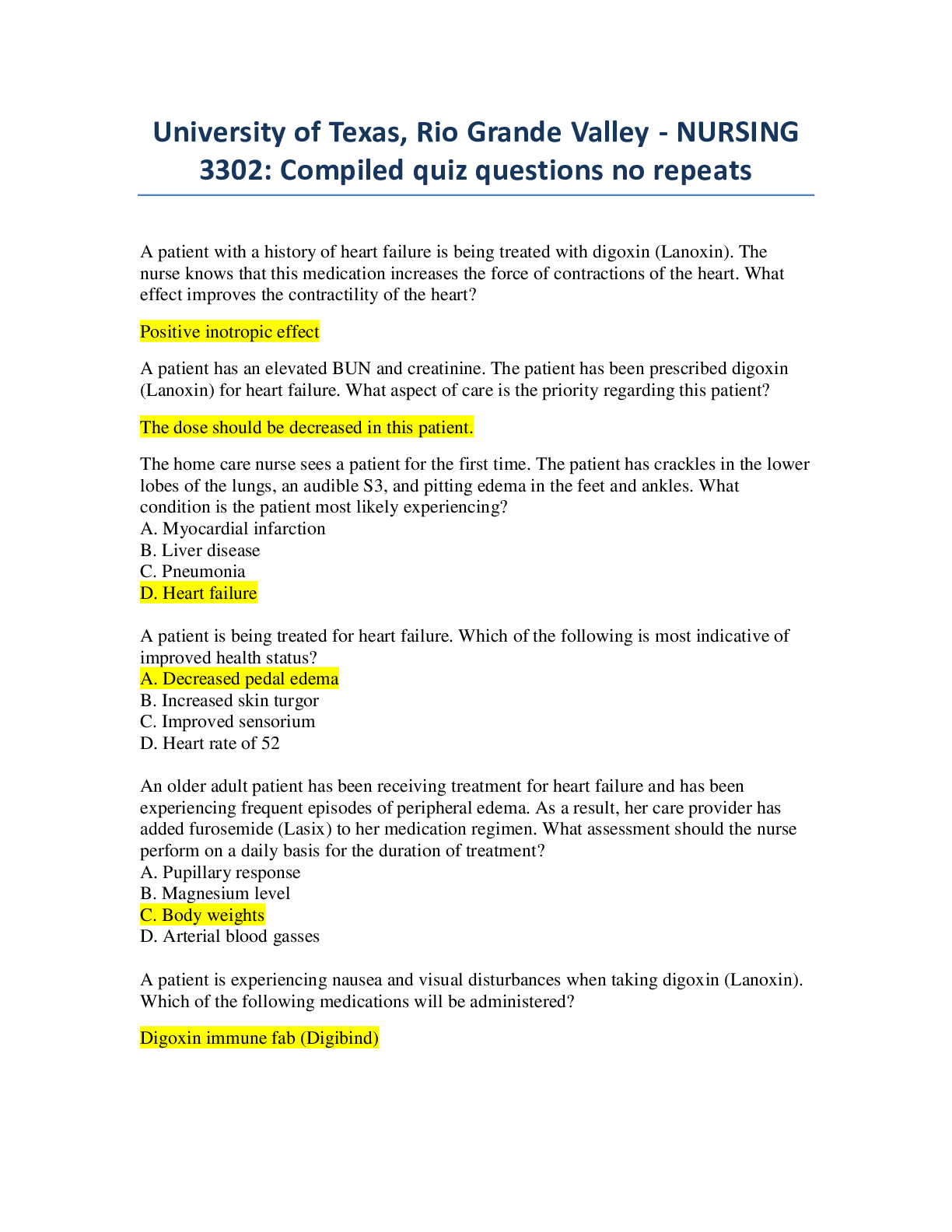
Buy this document to get the full access instantly
Instant Download Access after purchase
Add to cartInstant download
Reviews( 0 )
Document information
Connected school, study & course
About the document
Uploaded On
Jun 07, 2020
Number of pages
14
Written in
Additional information
This document has been written for:
Uploaded
Jun 07, 2020
Downloads
0
Views
51



